Landfill Gas to Energy
Landfill Gas Management System
The Secure Sanitary Landfill has been accepting and managing Cape May Counties waste since 1984. This waste, as it decomposes in the landfill creates Landfill gas. Landfill gas (LFG) is a natural byproduct of the decomposition of organic material in the Landfill. LFG is composed of roughly 50 percent methane (the primary component of natural gas), 45 percent carbon dioxide (CO2), and small amounts of nitrogen, oxygen, and other gases, also known as balance gases.
With the use of engineered controls, LFG can be captured, converted, and used as a renewable energy resource. Capturing and managing the LFG reduces odors and significantly reduces the amount of methane escaping into the atmosphere contributing to greenhouse gasses. LFG is a renewable energy source and can be used to provide fuel to run electrical generators and boilers, generate revenue, and create jobs while protecting the environment. The CMCMUA’s Sanitary Landfill has a state-of-the-art collection system that collects LFG that is generated within the waste mass.
The Sanitary Landfill collects LFG using both vertical and horizontal collection wells that through a series of various sizes of vacuum pipelines, connect to two (2) 150 HP blowers that create a vacuum throughout the landfill drawing the LFG into the collection system. This system directs the collected gas to a central point where it is processed and treated. From this point, the gas can be flared to destroy greenhouse gas emissions or beneficially used in energy production.
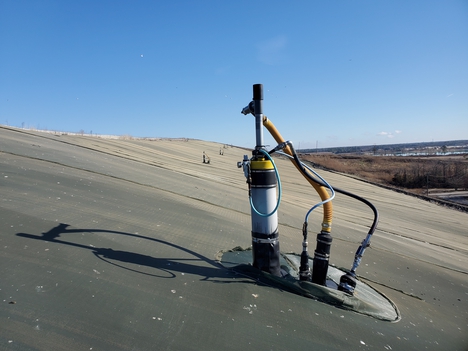
Vertical LFG Collection Well Head
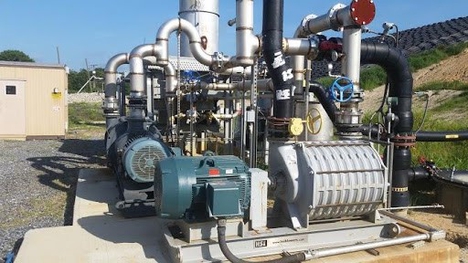
Central Collection Point with Two 150 HP Blowers
During 2019 and 2021, the CMCMUA installed an additional 26 vertical gas wells and expanded the vacuum pipe system on the southeastern side of the landfill to enhance the capabilities of the LFG collection system. A compressor building was constructed which provides a continuous supply of compressed air to pumps that are installed in each gas well to remove any collected liquids, keeping the well an active gas collection point. A Sulfur Removal System has been incorporated into the Collection System to remove Sulfur from the LFG as well as a Chiller Skid, capable of removing condensate from the collected LFG. Both the Sulfur Removal System and the Chiller Skid condition the LFG, making it a more desirable fuel source. Increased pipe sizes, a Sulfur Removal System, a Condensate Removal System, and the installation of an additional 20 acres of the temporary geosynthetic cap, has made the existing LFG collection system more efficient and capable and collecting more LFG for use in energy production, minimizing nuisance odors, reducing greenhouse gases, and further protecting the environment of Cape May County.
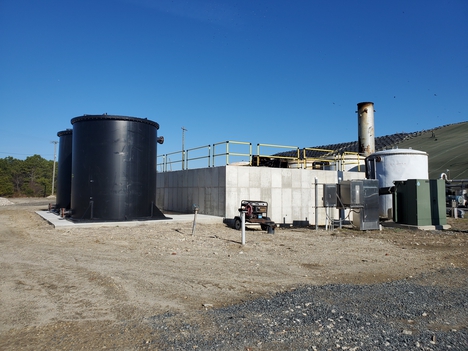
Sulfur Removal System
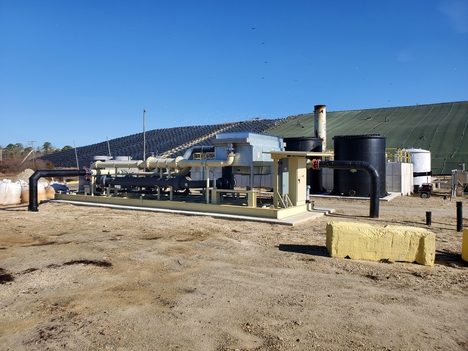
Chiller Skid
Woodbine Developmental Center Uses LFG
The Woodbine Developmental Center (WDC) in Woodbine, New Jersey provides a wide range of habilitation, behavioral and medical services and supports those with developmental disabilities. The facility is heated and cooled using two (2) boilers which are fueled by natural gas. The CMCMUA provides Landfill gas (LFG) to the WDC through a pipeline that runs from the Sanitary Landfill to the WDC. The LFG supplied to the WDC supplements the fuel requirements for the boilers. In 2021 alone, CMCMUA provided more than 25,000,000 cubic feet of LFG to the WDC to supplement the fuel needs of the facility.
CMCMUA Electrical Generating Station
In 2013, CMCMUA installed three (3) Jenbacher JMS 320 Electrical Generating Engines at the Sanitary Landfill. Each of these three Generating Engines is capable of producing 1.0 megawatt of electricity per hour using the LFG as the sole source of fuel. The electricity is used to supply all the electrical needs of the entire Environmental Complex including the Landfill, gas management system, recycling center, scale house, and maintenance facility. All excess electricity generated that is not needed by the Environmental Complex is sold to the PJM grid. Since the commissioning of the generating engines, more than 87,000 Megawatts of electricity have been produced.
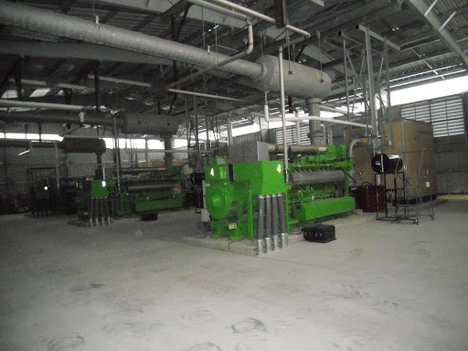
Electrical Generating Engines